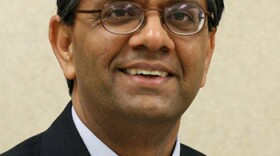Sustainability is an essential aspect of today’s buildings and systems -- along with being an important way of operating and living today -- and the University of Nevada, Reno is no exception. The university’s innovative systems, designs and practices -- and the people leading the sustainability efforts on campus -- are the topic of conversation on KUNR'sBeyond the Headlines.
University President Marc Johnson visits with John Sagebiel, Ph.D., the university's assistant director of Environmental Programs in the Department of Environmental Health and Safety who has a wide-ranging interest in the topic sustainability.
(Interviewed by KUNR's David Stipech; air date 7-24-15.)
Sustainability goes beyond "green buildings." It means meeting our needs today without compromising the ability of future generations to meet their needs. -- John Sagebiel
University of Nevada, Reno's Sustainability Position and Highlights
POSITION: The University of Nevada, Reno has undertaken an ambitious range of sustainability goals and strategies in an ongoing effort to integrate cutting-edge practices, planning, partnerships and community engagement into all of our operations. We work to achieve campus sustainability and an overall “green” campus by reducing our ecological footprint in areas such as climate, energy, waste, transportation and our built environment.
SUMMARY: The total number of dollars expensed for more than 50 projects related to sustainability on campus has totaled $509,971,386. From 2005-2014, energy conservation efforts resulted in a 12.8 percent reduction in kilowatt-hours and an 18.8 percent reduction in the cost of purchasing electricity.
LEADERSHIP IN ENERGY AND ENVIRONMENTAL (LEED): The University is designing and constructing LEED certified or equivalent buildings in an effort to maximize energy efficiency and make the most of renewable, sustainable resources. The University has invested more than $496,000 in 11 projects since 2006 (list includes the Joe Crowley Student Union, IGT-Mathewson Knowledge Center and newly completed Peavine Hall) to achieve either LEED Silver or Gold Certification or LEED Silver Equivalent status. During all new construction projects, occupancy sensors are installed throughout, and day-lighting sensors are being installed per Energy Code.
PARKING LIGHTING: The University is upgrading all parking lighting to high efficiency lighting with day/night sensors where practical to improve both security and save on utility bills. This investment has totaled more than $549,000 and includes the Brian J. Whalen, Sierra Street and West Stadium Parking complexes.
PHOTOVOLTAIC SOLAR PANELS: As part of the University’s three-fold goal to reduce energy consumption, to use alternative energy sources where possible and to provide our students with real-world experience on these systems, the University has installed solar panel systems on several on- and off-campus buildings, for an investment of more than $524,000.
HEATING, VENTILATION AND COOLING: Heating, ventilation and cooling comprises probably the greatest opportunity for energy savings and has been a major focus. With more than $8.9 million invested since 2009, this effort has included an initiative to develop a two-loop, multi-phase chilled water system for the south campus. This system will provide substantial energy savings by eliminating an estimated six chilled water plants.
ROOF REPLACEMENT: Ten projects between 2012-2015 replacing entire roofs, or sections of roofs, on eight buildings, have increased the protection of the buildings and their insulation value, thereby reducing energy costs. This investment has totaled more than $2.2 million.
LIGHTING AND CONTROLS RETROFITS: The University has focused some level of funding on upgrading lighting and control systems. Research shows that improvements in this area can reduce energy consumption by 35 to 55 percent and provide paybacks on the investment in 2.7 to 10.7 years. The University has invested more than $620,000 in this area.
WATER USE:
- Athletic fields are Turf Grass (plastic, non-water using).
- Grounds Services has upgraded irrigation controller system and other management tasks to allow them to detect leaks and waste easily.
- Inside buildings, the University only has low-flow devices on toilets and sinks.
- All new faucets replaced in the past two years have been lower flow rates than the ones replaced (1.5-2.2 gallons per minute v. 3.5 gpm).
- Recently installed new programmable central irrigation control system that reduces irrigation water consumed.
- The University is currently conducting research on how best to deal with historic drought (includes water consumption calculations relative to student/employee headcount and 250 work days per year).
- Main Station Field Lab was the pilot program for use of effluent (treated waste or “gray water”) made available through Truckee Meadows Water Authority’s treatment systems. In 2002, the entire 800-acre Main Station Field Lab adopted the use of effluent water. As a result, 6.5 to 7 million gallons of water are saved and remain in the Truckee River annually.
SOURCE: University of Nevada, Reno










